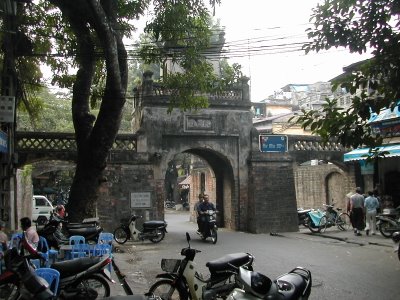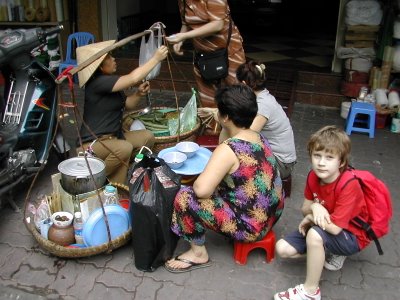Old Hanoi

At the heart of modern Hanoi is a small lake named Hoan Kiem, "Returned Sword". This moniker goes back to a legend about the 15th century national hero Le Loi who led a successful rebellion against the Chinese. Fishing in the lake outside the town walls, young Le Loi caught a golden sword in his net. Very Arthurian. This weapon he wielded in battle for many years before returning one day as a king to thank the lake's spirit with an offering. The gods at this point apparently felt that he needed no more assistance, and so the king, eyes agog, saw the sword fly from its scabbard out over the lake and into the mouth of a golden turtle surfacing for the occasion. Mission accomplished, sword returned.
There is actually a dwindling stock of massive turtles in the green water. One was caught in 1968 and is on display in a small 19th century temple on an islet, just off the site of an obelisk with a trippy inscription in three Chinese characters: "Write Turquoise Sky", that is, take that bamboo brush and scribble away at the firmament. "And so I throw the windows wide and call to you across the sky".

Hanoi's Old Quarter is just north of the lake, a moped-infested maze of narrow alleys lined by two- and three-story houses with storefronts at ground level. The typical building is called a Tube House, as it is very narrow and very long, wall to wall with its neighbours. Before electrical lighting, such a structure would have several open-air courts along its length to admit light and air. After lunch today we visited a renovated late-19th century example and got a feel for what they were like.

Like a Medieval European city, the Old Quarter was walled and its streets specialised by trade: Butcher Street, Baker Street etc. And as with most of its European equivalents, the Old Quarter's walls have been torn down and the streets' specialities mostly survive only as names. No longer does anyone expect to buy fish in York's Fishergate or cups and pots in its Coppergate ("gate" here being a Scandinavian loan word, cf. Sw. gata). But although many of the old specialities are gone, specialisation itself is still very much apparent in Hanoi: Oil Street merchants deal almost exclusively in shoes, Drum Skin Street has bags and upholstered furniture, Sugar Street has clothing. This can be frustrating for the tourist who wants a snack and can find nothing but ladies' fashion.

I like the food streets, just like I love to prowl covered markets in Europe. In addition to a lot of familiar stuff, Hanoi's small-time butchers and fishmongers offer some pretty wild goods. We saw tiny wiggly leeches sold by the cupful, maggots, live poultry, a little runaway crab making its last stand in the dirty street, but funnily no identifiable cuts of dog.
Dog is apparently holiday food, associated with certain phases of the moon, believed to cleanse your system and increase erectile stamina. I gather that erection problems are kind of an international ethnic trauma among Far Eastern men, with sad consequences for the tigers, rhinoceri and snakes that get made into, well, snake oil. Looking at the region's population growth figures, I can't really see why these guys worry. It's not like they have anything left to prove.
[More blog entries about Vietnam; Vietnam.]
Labels: Vietnam



1 Comments:
Oh, what a beautiful picture of the most wonderful boy in the world! And he looks so much like his father. The little smile, the posture...
Post a Comment
<< Home